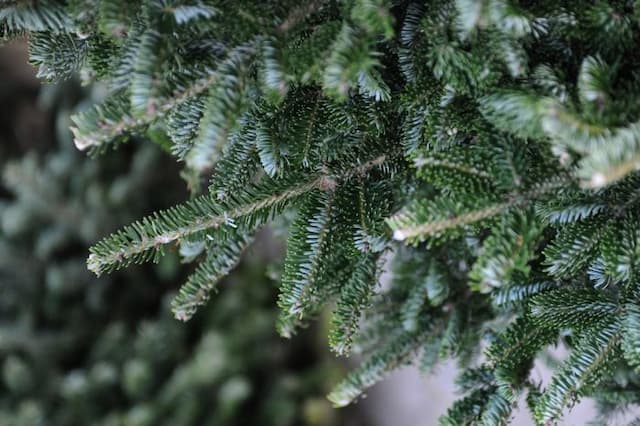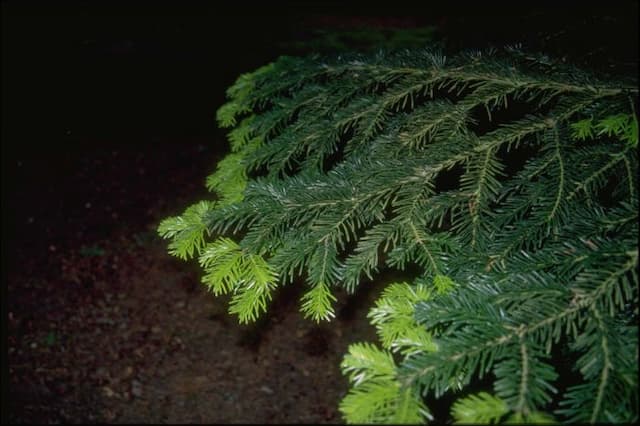Caucasian fir 'Golden Spreader' Abies nordmanniana subsp. nordmanniana 'Golden Spreader'

ABOUT
'Golden Spreader' is a slow-growing evergreen conifer making a small shrub of spreading, bushy growth, wider than tall. Foliage bright golden-yellow, particularly in winter
About this plant
 Names
NamesFamily
Pinaceae
Synonyms
Nordmann Fir, Caucasian Fir, Golden Spreader Nordmann Fir, Golden Spreader Fir, Golden Spreader Caucasian Fir
Common names
Abies nordmanniana subsp. nordmanniana 'Golden Spreader'.
 Characteristics
CharacteristicsLife cycle
Perennials
Foliage type
Evergreen
Color of leaves
Green
Height
2 feet [0.61 meters]
Spread
4 feet [1.22 meters]
Plant type
Tree
Hardiness zones
4
Native area
Caucasus
Benefits
 General Benefits
General Benefits- Ornamental Appeal: Abies nordmanniana 'Golden Spreader' adds visual interest to gardens with its unique golden foliage and spreading habit.
- Low Maintenance: This conifer requires minimal pruning and care once established, which is attractive to gardeners seeking low-maintenance landscaping options.
- Drought Tolerance: Once established, it can tolerate periods of drought, reducing the need for frequent watering.
- Adaptability: It is adaptable to a range of soil types as long as they are well-drained, making it suitable for various landscapes.
- Wildlife Habitat: Provides shelter and nesting sites for birds and other wildlife within the garden ecosystem.
- Seasonal Interest: Offers year-round color and texture in the landscape, with its golden needles adding warmth especially in the winter months.
- Slow Growth Rate: Its slow growth rate makes it ideal for small gardens or as a specimen plant where space is limited.
 Medical Properties
Medical PropertiesThis plant is not used for medical purposes.
 Air-purifying Qualities
Air-purifying QualitiesThis plant is not specifically known for air purifying qualities.
 Other Uses
Other Uses- Holiday Decor: The foliage of Nordmann fir can be used in wreaths and garlands for festive decorations due to its lush green appearance and durability.
- Photography Backdrops: The dense and uniform growth habit of the Nordmann fir makes it an excellent backdrop for outdoor photography.
- Living Fences: Planted in rows, Nordmann firs can serve as a privacy screen or windbreak, providing a dense barrier against noise and wind.
- Soundproofing: Because of its density, the Nordmann fir can help dampen and absorb sound, making it a useful planting near roads or in urban settings.
- Crafts: The wood of Nordmann fir can be used in woodworking or crafts projects, such as making small ornaments or decorations.
- Erosion Control: The extensive root system of the Nordmann fir helps stabilize soil on slopes or areas prone to erosion.
- Habitat Creation: When planted in groups, Nordmann firs can create a suitable habitat for birds and other wildlife, offering shelter and food sources.
- Educational Tool: This plant can be used in botany studies or gardening workshops to educate about conifer growth patterns and care.
- Theatrical Uses: Nordmann firs can be used on stage set designs to replicate outdoor scenes or to create a forest-like atmosphere.
- Winter Interest: The frost-resistant nature of the Nordmann fir provides visual interest in gardens during the winter months when other plants may have died back.
Interesting Facts
 Feng Shui
Feng ShuiThe Caucasian Fir, commonly referred to as the Nordmann Fir in the context of Feng Shui, can be used to introduce wood element energy into a space, symbolizing growth and vitality. Place it in the east sector of a garden or room to foster health or the southeast to enhance wealth and abundance.
 Zodiac Sign Compitability
Zodiac Sign CompitabilityThe Nordmann Fir is not used in astrology practice.
 Plant Symbolism
Plant Symbolism- Longevity and Endurance: As a type of fir tree, the 'Golden Spreader' Nordic fir symbolizes longevity and endurance, reflecting the tree's ability to live for many years and weather diverse environmental conditions.
- Resilience: The resilient nature of fir trees indicates an ability to withstand hard times and bounce back, representing the human capacity for resilience in the face of challenges.
- Festivity and Celebration: As a variety often associated with Christmas, fir trees embody the spirit of festivity and celebration, bringing joy and warmth to holiday traditions.
- Growth and Renewal: The evergreen nature of fir trees suggests continual growth and renewal, symbolizing the idea that life keeps progressing regardless of setbacks.
- Hope: Historically, evergreens like fir trees represent hope, with their green foliage persisting even through winter, they are a reminder that life continues and brighter days lie ahead.
 Water
WaterFor the Caucasian fir, commonly known as the Nordmann fir 'Golden Spreader', the watering schedule should be consistent to keep the soil slightly moist but not soggy. During the growing season in spring and summer, watering once every week with about 1 to 2 gallons of water is usually sufficient, depending on rainfall and soil drainage. In the fall and winter, reduce watering to every other week to prevent root rot, especially if the plant is in a region with winter precipitation. Ensure that the water is distributed evenly around the base of the tree, extending out to the edge of the branch spread. If the weather is extremely hot or dry, monitor the soil moisture closely and water more frequently to keep the plant healthy.
 Light
LightThe Nordmann fir 'Golden Spreader' prefers a location with full sun or partial shade for optimal growth. Plant it in a spot where it will receive at least six hours of direct sunlight daily. This fir variety can tolerate some shade, but too little light may reduce its growth and the vibrancy of its foliage. Avoid deep, dense shade areas since this can lead to a weaker, less dense plant form.
 Temperature
TemperatureThe Nordmann fir 'Golden Spreader' is hardy and can tolerate cold temperatures, typically surviving in zones with minimum temperatures of -20 to -30 degrees Fahrenheit. It thrives in a range of temperatures but does best in cooler climates, preferring an average range of 40 to 70 degrees Fahrenheit. It is important to protect the plant from extreme heat, as temperatures consistently above 80 degrees Fahrenheit can stress the plant and potentially cause damage.
 Pruning
PruningPruning the Nordmann fir 'Golden Spreader' is typically done to maintain its attractive shape and to remove any dead or damaged branches. The best time to prune is in late winter or early spring before new growth begins. Cut back to a healthy bud or branch and make clean cuts to avoid damaging the tree. Pruning once a year is sufficient for maintaining its form and encouraging healthy, dense foliage.
 Cleaning
CleaningNot needed
 Soil
SoilThe optimal soil mix for the Caucasian Fir 'Golden Spreader' should be well-draining, rich in organic matter, with a slightly acidic to neutral pH between 6.0 and 7.0. A mix of loam, peat or compost, and sand would provide a suitable growing medium, ensuring good drainage while retaining moisture and nutrients.
 Repotting
RepottingThe Caucasian Fir 'Golden Spreader' generally does not require frequent repotting as it is a slow-growing plant. When young, repotting may be needed every 2-3 years. Mature plants are typically planted directly in the ground and do not need repotting.
 Humidity & Misting
Humidity & MistingCaucasian Fir 'Golden Spreader' thrives in moderate to high humidity levels. While specifics can vary, aiming for a humidity level around 50% or higher is often suitable, replicating its natural mountainous environment. It is tolerant to lower humidity but may thrive best with higher ambient moisture.
 Suitable locations
Suitable locationsIndoor
Place in bright, indirect light, and ensure good air circulation.
Outdoor
Plant in well-draining soil with a sunny to partially shaded site.
Hardiness zone
4-7 USDA
 Life cycle
Life cycleAbies nordmanniana subsp. nordmanniana 'Golden Spreader,' commonly known as Nordmann Fir, begins its life cycle when its seeds, housed within cones, germinate after a period of cold stratification. The seedlings emerge and grow slowly, establishing a strong root system and developing into young saplings characterized by their rich, green foliage. As the saplings mature into adulthood over many years, they develop a spreading habit with golden-yellow needles, especially pronounced in full sun. Mature trees are conical and may reach a smaller height due to the 'Golden Spreader' cultivar's compact nature. These trees then produce cones at maturity which will shed seeds, ensuring the continuation of the species. The Nordmann Fir can live for many decades, and during its life, it is resilient to pests and diseases, provided it is grown in appropriate conditions with adequate space, light, and well-drained soil.
 Propogation
PropogationPropogation time
Spring to Summer
The most popular method of propagation for the Caucasian fir, specifically the variety 'Golden Spreader', is through grafting. This method involves taking a piece of the 'Golden Spreader' and attaching it to the rootstock of a common Abies nordmanniana. Grafting is typically done in late winter or early spring, before the new growth starts. The scion, which is a shoot with healthy buds, is carefully joined to a cut in the rootstock so that the vascular tissues align and allow for successful transportation of nutrients. The graft is then wrapped and sealed to prevent dehydration and infection, after which it is left to heal and grow. Grafting ensures that the desirable characteristics of 'Golden Spreader', such as its golden foliage, are preserved in the new trees.








